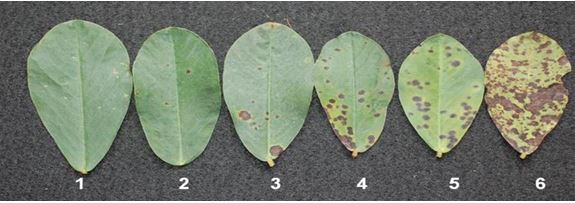Application of programs associated or not with the adjuvant Oxiativo® for the control of black spot in the peanut
DOI:
https://doi.org/10.17648/sas.v1i2.77Keywords:
Arachis hypogaea L., Cercosporidium personatum, Chemical control, Spray conditionerAbstract
1
ÂThe peanut culture is considered the fourth most planted olegionosa in the world, however, over the years, it has faced phytosanitary problems, mainly related to phytosanitary diseases, which have caused negative impacts on production. The present study aimed to evaluate the effect of fungicide application of programs associated or not with the Oxiativo® adjuvant in the control of Cercosporidium personatum (black spot) in the peanut. The experimental design was in randomized blocks with four replications, composed by five treatments, where: Standard (2 initial applications of Difere®, 1 application of Bravonil® 720 SC and 4 applications of Bravonil® 720 SC + Opera®); Standard + Oxiativo® (Oxiativo in all applications); Standard + Difere® (Difere in the last 4 applications) and Standard + Difere® + Oxiativo® (Difere in the last 4 applications and Oxiativo in all applications) and a control treatment (no application). The starting of applications was at 30 DAE in seven applications, in the IAC OL 03 peanut variety. Nine black spot severity assessments were carried out at seven-day intervals. From these data, the area under the disease progress curve (AUDPC) and productivity assessment were calculated. It was concluded that the Standard + Difere® + Oxiativo® treatment was the one that resulted in the highest productivity and the addition of the Oxiativo product to the application program was efficient in controlling the black spot of peanuts.
Downloads

Downloads
Published
How to Cite
Issue
Section
License
Autores concordam com os seguintes termos:
a) Os autores mantêm os direitos autorais e concedem à revista o direito de primeira publicação, com o trabalho simultaneamente licenciado sob a LicençaAttribution-NonCommercial-ShareAlike 4.0 International, que permite o compartilhamento do trabalho com reconhecimento da autoria e publicação inicial na Revista SAS. A licença permite o uso, a distribuição e a reprodução irrestrita, em qualquer meio, desde que devidamente citada a fonte. Essa licença permite também que outros remixem, adaptem e criem a partir do seu trabalho para fins não comerciais, desde que atribuam a você o devido crédito e que licenciem as novas criações sob termos idênticos.
b) Não cabe aos autores compensação financeira a qualquer título, por artigos ou resenhas publicados na South American Sciences.
c) Os conceitos expressos nos artigos publicados na South American Sciences são de inteira responsabilidade de seus autores.








